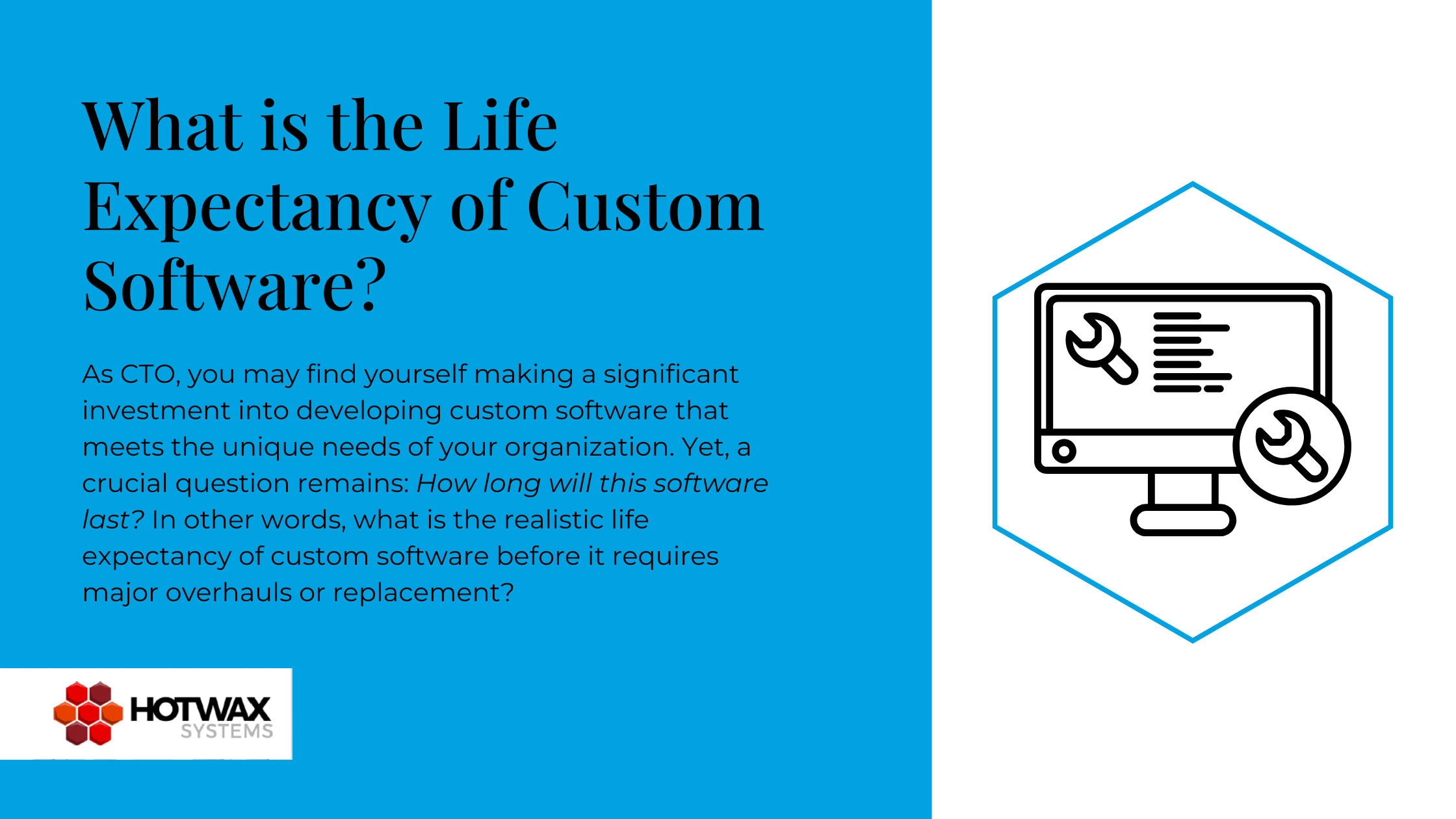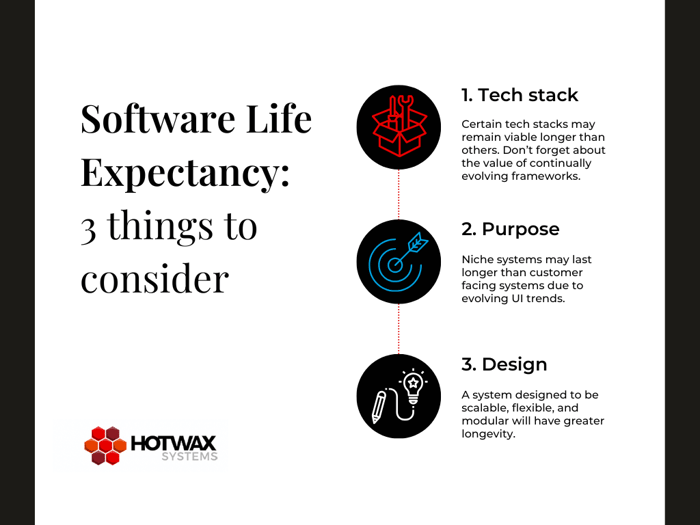As CTO, you may find yourself making a significant investment into developing custom software that meets the unique needs of your organization. Yet, a crucial question remains: How long will this software last? In other words, what is the realistic life expectancy of custom software before it requires major overhauls or replacement?
Software life expectancy
Unlike physical assets, custom software doesn't come with a definitive expiration date. The lifespan varies widely based on:
- Technology stack: Certain tech stacks may remain viable longer than others. One thing to be aware of is that while frameworks naturally evolve, standalone custom software doesn’t. This is something to consider when interviewing custom software providers: what tech stack are they proposing / where do their capabilities lie? For example, our team is versed in a variety of tech stacks, but we also rely on tried and true frameworks like Moqui and OFBiz that can be customized and have been proven to last for decades.
- Software purpose: Software designed for specialized or niche processes may have longer longevity than customer-facing software, which must adapt to evolving user interfaces and trends. However, a good dev team plus responsive technology choice can make this a non-issue as things can be updated to stay current.
- Design: A system built with scalability, flexibility, and modularity in mind will generally last longer since it can be more easily updated and maintained over the years. For example, we have multiple clients with custom systems who have been with us for 10+ years.
The best custom software systems will be built so that they can undergo continuous improvement as needed in order to extend the lifespan and usefulness without requiring a future overhaul.
Factors that affect software longevity
- Technology advancements and dependencies
Software that relies on outdated technologies may face a shorter lifespan, so working with a custom enterprise software provider that keeps an eye on the tech landscape is crucial since vendor and community support for libraries and frameworks can shift quickly. - Business and market evolution
Business needs evolve as markets change, and software must adapt. CTOs should ensure software development aligns with the company’s long-term strategy to maximize its relevance and usefulness over time. - Security requirements and compliance
Security updates are essential to enable custom software to handle new vulnerabilities. And regulatory compliance standards, like GDPR or HIPAA, may necessitate updates to data handling and storage practices, which, if unaddressed, can put the software at risk.
Strategies for extending software lifespan: build vs buy
- Modular architecture
Building software with modular components allows specific parts to be customized without a complete overhaul. Think of this as an 80 / 20 version of the classic “build vs buy” question. With this model, 80% of the software is already built, and 20% can be "bought" to customize. This way CTOs can change or scale individual services rather than re-engineering the entire system. This flexibility is especially valuable in complex systems that need to adapt to new features or process changes. - Adopt a continuous improvement mindset
By treating custom software as a continuously evolving project, you can address performance bottlenecks, add new features, and resolve security vulnerabilities over time. - Prioritize upgradability
A focus on upgradability during the development phase can ensure that future updates are smoother and less costly. - Plan for regular audits and reviews
Conducting audits and reviews at regular intervals can help ensure the software is performing well and adheres to current best practices. Audits can reveal potential bottlenecks, making it easier to proactively plan upgrades and updates before major issues arise.
Signs it's time to modernize or replace custom software
Despite your best efforts, there will come a point when your software may need modernization, updates, or even replacement. Here are some common indicators that signal it’s time to take action:
- Performance bottlenecks: The system is struggling to keep up with the current workload, resulting in slow response times or crashes.
- Increasing technical debt: Frequent patches and workarounds indicate that technical debt is accumulating, which may lead to more frequent failures and higher maintenance costs.
- High maintenance costs: If the cost of maintaining the software outweighs its value, it may be more economical to replace or rebuild the system.
- Security vulnerabilities: Outdated libraries or lack of security updates make the software increasingly vulnerable to threats.
- Compatibility issues: New technologies, hardware, or other software may no longer integrate easily with your system, making it challenging to expand or add features.
When to replace vs when to refactor
As your custom software approaches the end of its lifecycle, the choice between replacement and refactoring becomes critical. A complete rewrite might be necessary if the core architecture is fundamentally outdated or if the software is tightly coupled to obsolete technologies.
However, if the system remains relatively solid but needs updates to specific modules, a refactor or partial rebuild (remember the 80 / 20 model mentioned earlier) can be a more cost-effective and ultimately rewarding path.
Factors to consider in the decision:
- Current vs projected cost of maintenance: How much are you spending now vs how much will you spend in the long run if you make the necessary custom updates?
- Availability of new technology that solves key limitations: What system(s) are you running and are they connected to communities that are continually innovating?
- Business process changes that require significant rework: One of the main reasons businesses invest in software at all, let alone custom software, is to help them streamline their essential processes. If you find you're in need of better, more efficient processes, it might be time to replace or refactor your system.
Conclusion
The life expectancy of custom software is influenced by both technological and business factors. By designing for modularity, investing in maintenance, and adopting a flexible, 80 / 20 approach, CTOs can extend the value and lifespan of custom software.
A continuous improvement mindset and proactive monitoring will further ensure that your custom software continues to serve its purpose effectively, even as needs evolve.
With thoughtful planning, custom software can serve as a valuable and resilient asset for years—if not decades—to come.






